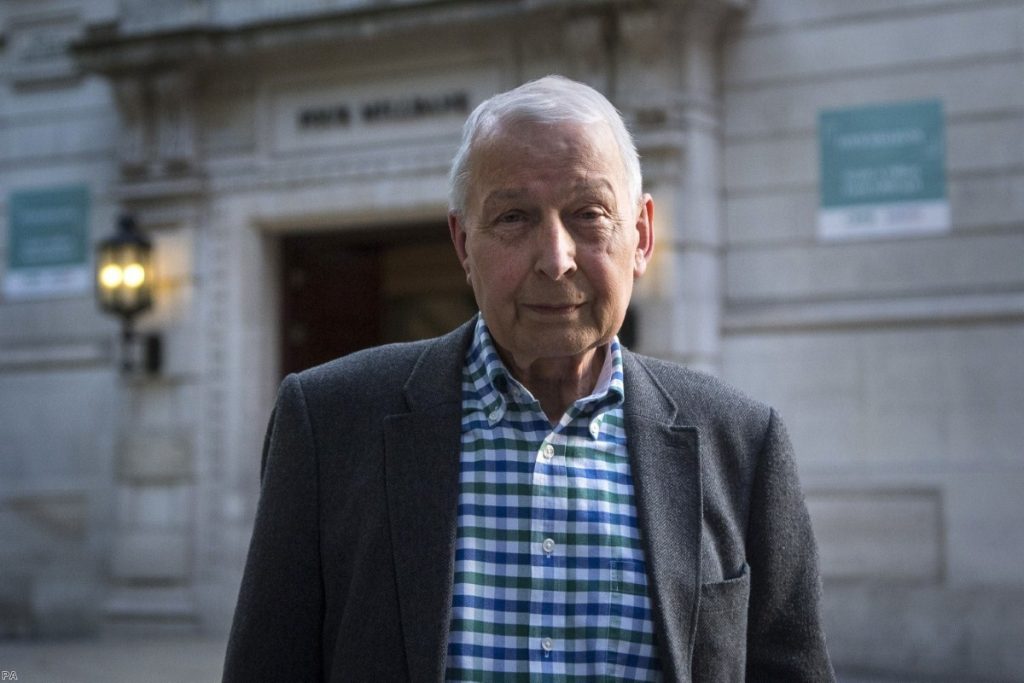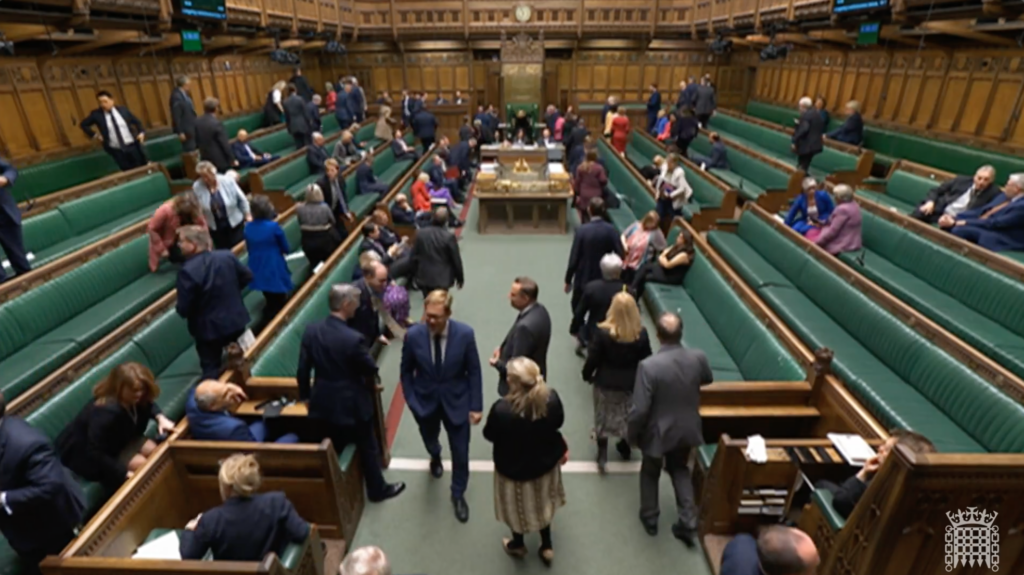24th April 2024 – The result of a General Election Today
In late April 2024, the Labour Party maintained a steady 19% poll lead over the Conservatives, largely unchanged from February 2024.
Although the two latest polls showed tentative signs of the Conservatives increasing their support by a couple of percentage points, the party’s trend polling across April as a whole, continued to sit as low as it has ever done at any point during this parliament.
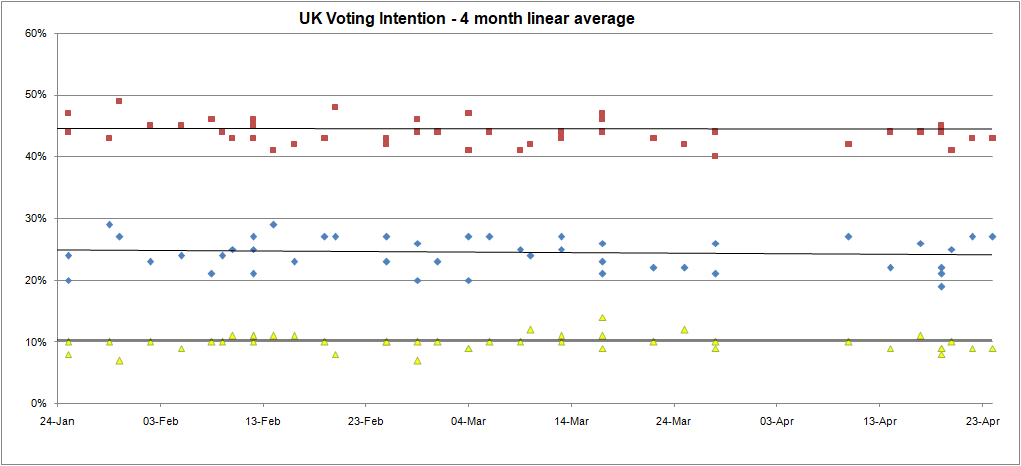
The overall polling averages extrapolated in the 3 weeks to April 24 place Labour on 43.3%, the Conservatives on 24.0%, and the Liberal Democrats on 9.3%. Should a general election be held today, still using the parliamentary boundaries from 2019, this would likely lead to the following composition of the House of Commons:
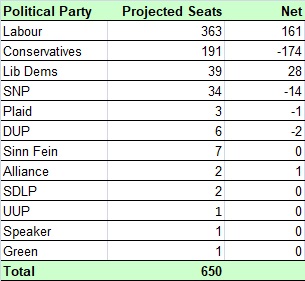
The result of a general election today is projected as a Labour victory with the party securing a working majority of 84 seats.
Under the current polling, Labour is still on course to win seats in parts of England where it has always been a distant spectator, such as both Bournemouth constituencies in Dorset, Southend East in Essex, Macclesfield in Cheshire, Bromley and Chislehurst in south east London, and the Isle of Wight.
If an election was held on the 2019 boundaries, former Conservative leader Iain Duncan-Smith, and the defence secretary, Grant Shapps, are amongst some of the leading political figures who would lose their seats to Labour.
Under any election held on this basis, the Liberal Democrats would also be on course to gain 27 seats from the Conservatives and one from the SNP. In any election held on the current boundaries, the Lib Dems would defeat the chancellor, Jeremy Hunt, energy secretary, Claire Coutinho, justice Secretary, Alex Chalk, and science secretary, Michelle Donelan. Both Mr Hunt and Ms Donelan are though likely to benefit from a move to a safer constituencies following the implementation of the impending boundary review.
Based on the most recent polling in Scotland, the Labour Party is currently on course to gain 15 seats from the SNP. The SNP would also lose 1 seat to the Liberal Democrats, but gain 2 from the Conservatives.
In Wales, Plaid Cymru is currently on course to lose one seat to Labour.
Trend support for the Green Party remains constant at around the 7% mark. Reform UK are also now polling in the region of 11%.
Notable recent election polls
The current voting intention trend can be seen in the most recent individual polls:
Savanta (24 April) which placed Labour on 43%, the Conservatives on 27%, and the Liberal Democrats on 9%.
Deltapoll (22 April) which placed Labour on 43%, the Conservatives on 27%, and the Liberal Democrats on 9%.
Opinium (20 April) which placed Labour on 41%, the Conservatives on 25%, and the Liberal Democrats on 10%.
The recent polling journey
In the aftermath of the 2019 General Election, the Conservative party enjoyed a healthy lead in the opinion polls. With the Conservatives polling over 50%, this lead briefly surpassed 20% at the beginning of the Covid pandemic in March and April 2020.
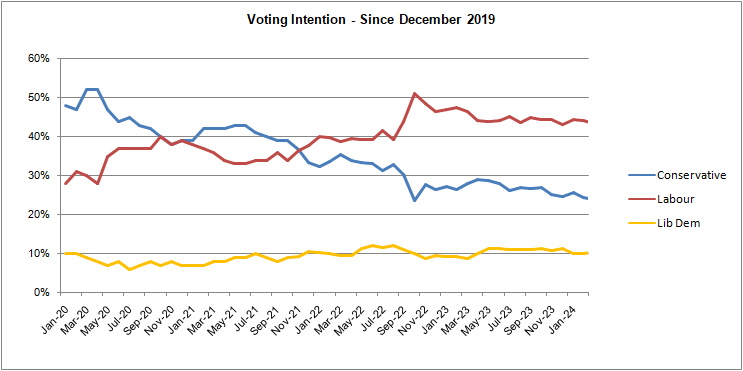
In the latter part of 2020, the Conservative’s lead in the polls diminished significantly. Indeed between October 2020 and January 2021, the two major parties were running neck and neck.
However, coinciding with the roll out of the coronavirus vaccine and the conclusion of Boris Johnson’s Brexit deal at the end of 2020, the Conservative party once again opened up a significant election poll lead over Labour. The Tory lead over Labour was as high as 10% throughout April, May and June 2021.
This Conservative poll lead coincided with the unusual event of a governing party winning a seat from the Opposition, as occurred in the May 2021 Hartlepool by-election.
Entering the summer, levels of Conservative support took a sudden 3% hit following the resignation of then health secretary, Matt Hancock, in June 2021.
Coming into the autumn, the Conservatives appeared to have suffered no adverse polling impacts from either their proposed rise in national insurance, or the autumn fuel shortages. Indeed Conservative support appeared to have grown slightly after Rishi Sunak’s October 2021 budget. When Sir Keir Starmer addressed the 2021 Labour party conference, amidst some signs of uneasiness within the party, he was still behind in the polls.
The end of 2021, showed how quickly politics can change.
In early November 2021, the furore over the resignation of the Conservative MP Owen Patterson saw the trend Conservative vote share fall by a further 3%. Conservative support then fell by a further 6% as the first Downing Street party allegations emerged. This reaffirms how sleaze and scandal remain such potent political weapons in British politics, ones which can quickly and easily cut through to voters.
Following a lull in political activity over Christmas 2021, the Conservatives appeared to be recovering in early 2022, clawing back approximately half of the poll losses that they had seen before the festive period.
However in the aftermath of fresh ‘partygate’ allegations in January 2022, followed by the publication of the Gray report in February 2022, the Conservatives dropped to their lowest polling position for over a quarter of a century, falling to a point last seen during the midst of the Major government back in the 1990s.
In late February 2022, and prior to the Russian invasion of Ukraine, there were some tentative signs that the Conservative position had recovered slightly from its early 2022 lows. With the Russian invasion of Ukraine heavily dominating the UK news agenda, the position of the UK’s political parties became somewhat becalmed during the spring on 2022 with no notable movements in the polls.
However amidst mounting pressure on Boris Johnson’s position in late June, and the drawn out nature of his resignation in early July, the Labour party once extended their lead over the Conservatives in the polls.
This lead was trending at around 8% at the point that Liz Truss became prime minister in September 2022.
Rather than experience a new prime ministerial bounce, in September 2022, the picture was not positive for Liz Truss. In the first three weeks of her premiership, the Labour lead over the Conservatives extended to 11%.
That lead then jumped to a staggering 24% in the three weeks after former chancellor Kwarsi Kwarteng’s mini budget and prior to Liz Truss’ resignation.
As the above graph shows, the damage done to the Conservative numbers by Liz Truss in September 2022, appears far more significant, and indeed long lasting, than the impact of partygate in the first half of 2022.
The impact of Liz Truss’ mini budget on underlying Conservative polling now resembles something of a ‘landmark moment’ , one comparable with Britain’s departure from the Exchange Rate Mechanism (ERM) under the Major government.
The Conservative party regained a minor amount of ground in the first 3 weeks of the Rishi Sunak premiership, but Mr Sunak’s honeymoon period was short lived, and those advances stalled soon after Jeremy Hunt’s autumn financial statement.
In the early part of 2023, and against a backdrop of public sector strikes, Labour started to increase its polling lead again and was once again approaching 50% in the polls. This level of support slipped back to below 45% in the spring of 2023 with slight suggestions that the Conservatives were edging ever so slightly up in the polls in the late summer of 2023.
However the second part of 2023 was bleak for the governing party, with the party seemingly unable to move its polling level above the mid 20% level. With Reform UK starting to poll double digits, the Conservative Party’s position in the polls has already fallen back further in early 2024.
Pollsters showed that Liberal Democrat voting intention during most of this Parliament has been constant at around the 9% mark with only temporary uplifts above this point.
General Election Polls – Methodology:
The above analysis of general election polls has been calculated through linear average equation modelling of the latest UK opinion polls of Westminster voting intention.
The headline data used in calculating these averages has been drawn from that laid out in the published polls of a number of leading firms: YouGov, Opinium, Survation, SavantaComRes, Redfield and Wilton, Techne, Delta Poll, and Ipsos Mori.
In terms of translating these election poll findings into a projected make up of the current House of Commons, Politics.co.uk has used the Butler method to calculate the current swing between the parties compared to the 2019 General Election.
Given that the parliamentary results in Wales and Scotland are influenced by the existence of a fourth major party (Plaid and the SNP), Politics.co.uk has undertaken separate analysis for swings in Welsh and Scottish constituencies. This analysis has drawn on the latest opinion polls that were specific to Wales and Scotland respectively.
In the case of Scotland, Politics.co.uk drew on the most recent Scottish voting intention polling data from Ipsos on 7 February 2024. In the case of Wales, Politics.co.uk has drawn on the most recent Redfield and Wilton poll produced on 26 January 2024. In the case of Northern Ireland, with its own political parties, Politics.co.uk has drawn on the LucidTalk opinion poll of 10 November 2023.
In terms of specific adjustments then made to this analysis, Politics.co.uk has assumed that the Green Party would continue to hold their safe seat in Brighton Pavilion (even after Caroline Lucas has stepped down), and that Sir Lindsay Hoyle would be returned as Speaker for his constituency of Chorley.
Politics.co.uk’s current Westminster projections are also drawn through an aggregate extrapolation of the data on election polls. They do not factor in the potential for further additional regional or constituency centric swings.
Similarly, the above analysis has been conducted based on the existing United Kingdom constituency boundaries. The Boundary Commission is currently in the midst of a review designed to better equalise constituency sizes. Although these recommendations are yet to be finalized, the next General Election will almost certainly be fought on a redrawn constituency map.
The commission has inrceased the number of seats in the South East of England (+7), London (+3), East Anglia (+3), and the South West (+3), at the expense of Wales (-8), the West Midlands (-3), the North East -3), the North West of England (-3), and Scotland (-2). Prior to the collapse in Conservative polling in 2022, it was suggested that equalising constituencies may assist the Conservatives by as many as 10 seats, given that the party’s seats in the south of England are currently numerically larger than those found elsewhere in the country.
The ‘Blue Wells’: 42 Conservative strongholds that could fall at the next election
‘Urban Flight’ – A real threat to many formerly safe seats in the Blue Wall











